Who's Got Your Back(link)? Checking Incoming Links Made Easy
Hansjan Kamerling
Jul 14
Why Checking Incoming Links is Critical for SEO Success

Check incoming links to website success starts with understanding who's linking to you and why. Here's the quick answer to get you started:
Essential Steps to Check Incoming Links:
- Use Google Search Console - Steer to Links > External links > Top linking sites
- Try specialized tools - Ahrefs, SEMrush, or Moz for comprehensive analysis
- Analyze the data - Look at Domain Authority, anchor text, and link quality
- Monitor regularly - Check monthly for new links and lost connections
- Take action - Build on opportunities and address low-quality links
Your website's backlinks are like digital votes of confidence. According to Google's Andrey Lipattsev, "Content and Links going into your site, are the two most important ranking factors followed by RankBrain." This means the websites linking to you directly impact your search rankings.
But here's the challenge: Most agency owners spend hours manually checking backlinks across different tools. You're drowning in spreadsheets, trying to make sense of Domain Authority scores, and struggling to turn backlink data into actionable insights for your clients.
The good news? Modern SEO platforms can automate this entire process. Instead of juggling multiple tools and manual reports, you can get real-time backlink analysis that actually helps you make better decisions.
I'm Hansjan Kamerling, and I've helped design SEO platforms for over 40,000 users, including systems that check incoming links to website performance at scale. Through my work with AI startups and fintech companies, I've seen how the right tools can transform time-consuming SEO tasks into strategic advantages.
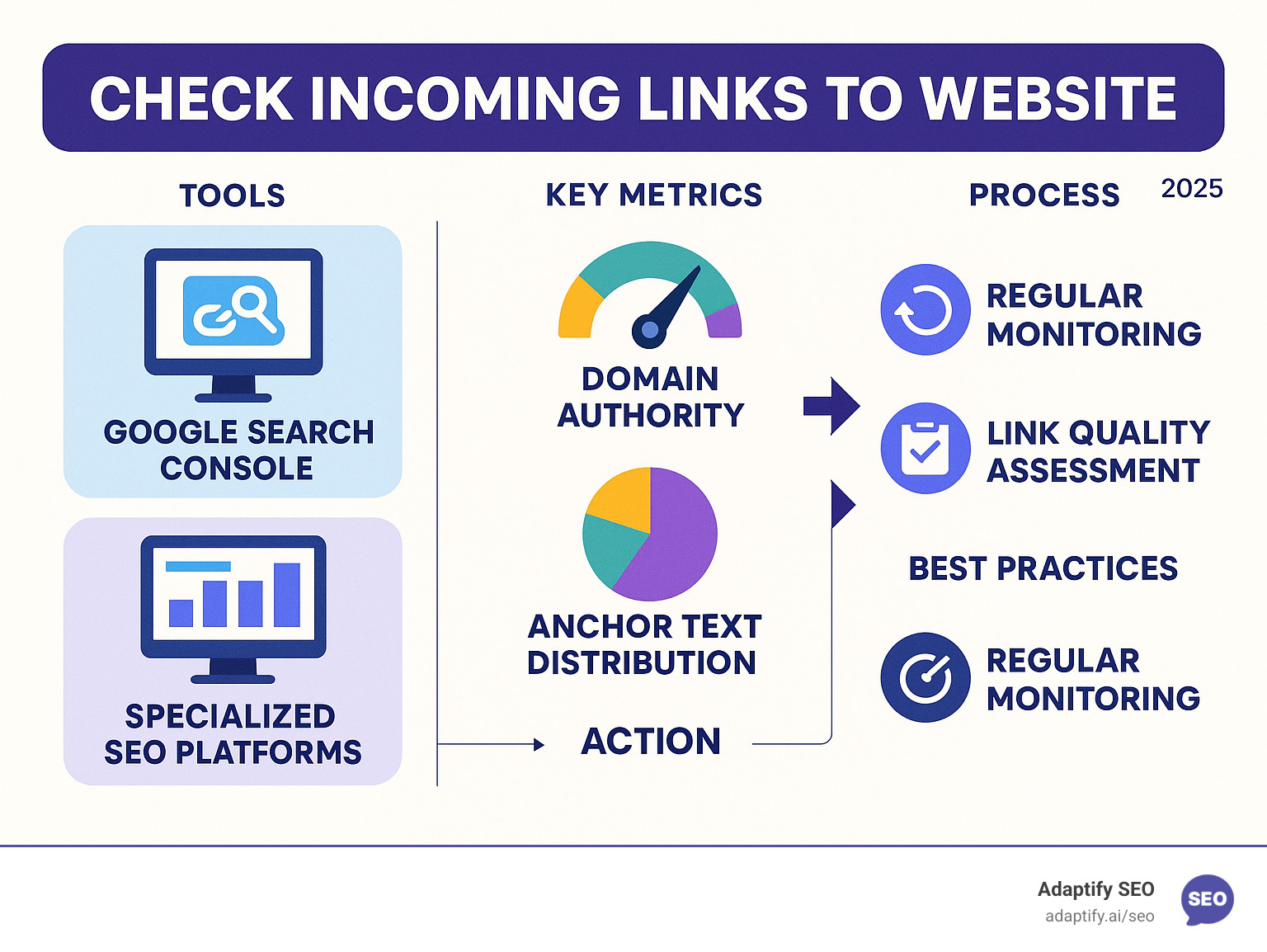
What are Backlinks and Why They Matter for SEO?
Backlinks—also called inbound or incoming links—are hyperlinks from one website to another. Think of them as a digital shout-out or recommendation.
Why do these digital nods matter for SEO? Search engines like Google see backlinks as "votes" for your content. More high-quality votes make your site appear more trustworthy and authoritative, helping your pages and domain rank higher. As SEORankTools notes, "Their total number and quality contribute to a domain's overall authority and help specific pages rank."
Backlinks are critical to Google's algorithm. According to Google's Andrey Lipattsev, "Content and Links going into your site, are the two most important ranking factors followed by RankBrain." The importance of quality has grown with Google's efforts to combat spam. The December 2022 link spam update was a clear warning against spammy tactics like buying links, which can cause ranking penalties. You don't just need many links; you need the right links.
Learn more about what backlinks are and why they're important for SEO.
The Power of Digital Endorsements
Think of your website in a popularity contest where each backlink is a vote. Not all votes are equal. A link from a respected, authoritative site in your industry carries more weight than one from a low-quality site. This concept is known as "link equity" or "link juice," where value passes from the linking site to yours.
Search engines assess these "votes" based on:
- Domain Authority (DA) / Page Authority (PA) (Moz): Moz's scores (1-100) predict how well a domain or page will rank. A higher score means stronger authority.
- Domain Rating (DR) / URL Rating (UR) (Ahrefs): Ahrefs' metrics (1-100) measure a site's or page's backlink profile strength. Ahrefs also shows estimated organic traffic to linking pages, a game-changer for evaluating link value.
- Authority Score (AS) (Semrush): Semrush's metric for domain strength. Some studies suggest its AS is more resilient to manipulation than Ahrefs' DR.
- Trust Flow / Citation Flow (Majestic): Majestic's Flow Metrics measure link quality (Trust Flow) and quantity (Citation Flow).
- Referring Domains: The number of unique websites linking to you. More unique domains generally mean a stronger profile.
- Anchor Text: The visible, clickable text in a hyperlink. It tells search engines what the linked page is about. A natural profile has a diverse mix of branded, naked URL, exact match, and contextual anchor text. Over-optimizing with exact-match anchors is a red flag for Google.
Understanding your backlink profile is a treasure map to SEO success. These digital endorsements significantly impact your site's visibility, authority, and rankings. The goal isn't just accumulating links. As SEOmator notes, "The quality is much more crucial than the quantity [of backlinks]." One high-quality, relevant link is more valuable than many from lesser-known sites.
How to Check Incoming Links to Your Website: Essential Tools
You understand why incoming links are vital; now let's get to the how. To effectively manage your SEO, you need to check incoming links to website accurately. There are several tools available, from free options like Google's to sophisticated paid platforms.
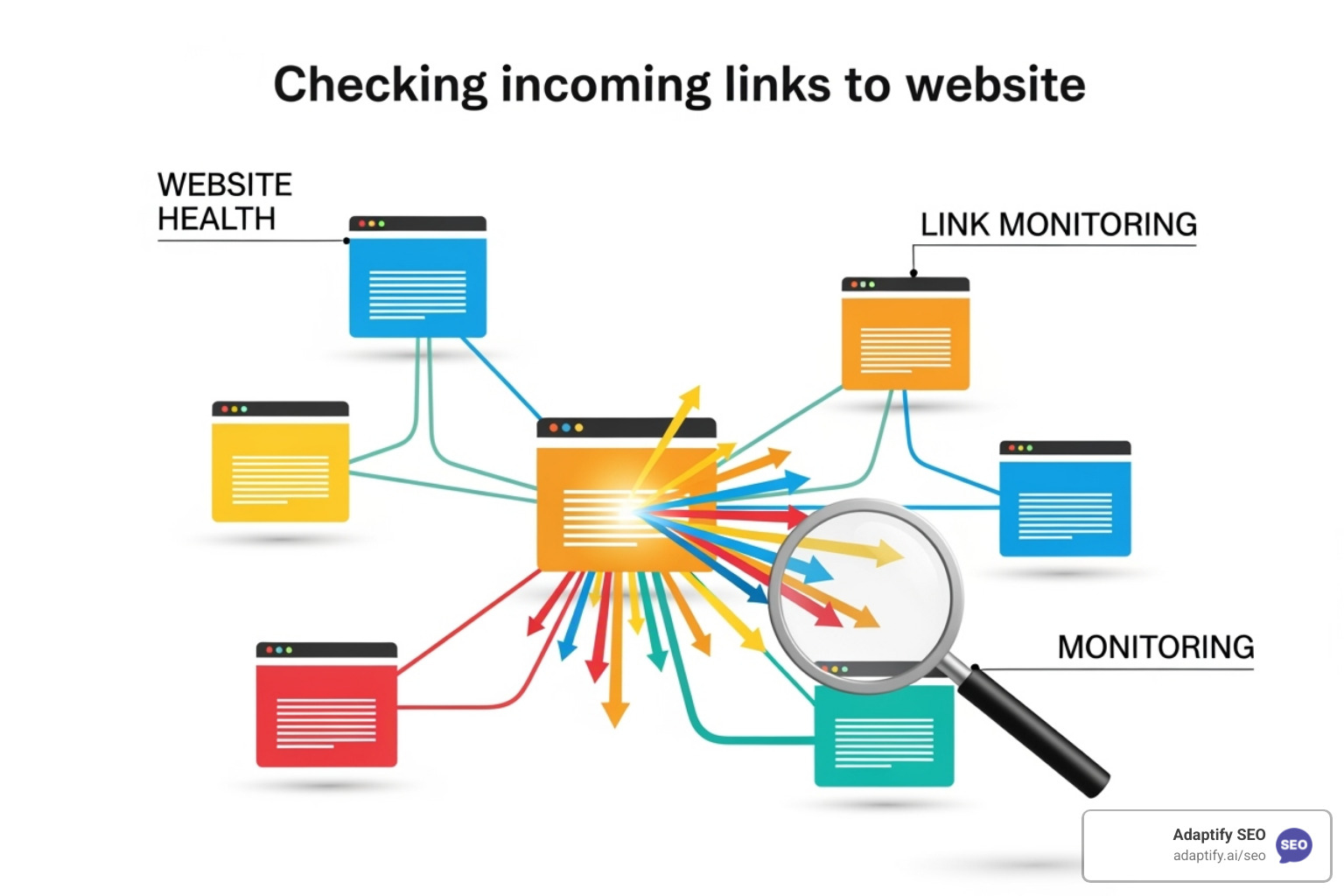
Free backlink checkers often limit results, offering a basic overview but lacking the depth needed for serious SEO. Even Google Search Console, while invaluable, has a 1,000-page report limit and lacks link quality metrics. For a comprehensive view and accurate data, a more robust solution is required. The scale of backlink data is immense; no single tool finds every link, but specialized platforms provide a much fuller picture.
Checking Incoming Links with Adaptify SEO
This is where a platform like Adaptify SEO shines. As an SEO platform designer, I know the value of an all-in-one solution. Adaptify SEO offers comprehensive backlink analysis with real-time data in a user-friendly dashboard.
With Adaptify SEO, you can gain:
- A complete overview: See all your incoming links, referring domains, and key metrics in one place.
- Advanced metrics: Access detailed data points to understand the quality and impact of each link.
- Competitor insights: Analyze competitors' backlink profiles to uncover their strategies and find new opportunities.
- Real-time monitoring: Stay on top of new and lost links.
Here’s a glimpse of what a backlink report looks like within our platform:
This integrated approach means you spend less time jumping between tools and more time strategizing.
Why Choose Adaptify SEO for Backlink Analysis?
For agencies and businesses aiming for serious SEO growth, an integrated solution is key. Adaptify SEO is more than a backlink checker; it's a comprehensive, AI-powered platform that streamlines your entire workflow, from strategy and content creation to PR link building.
Here’s why Adaptify SEO stands out:
- Integrated Solution: Adaptify SEO connects backlink data to your overall strategy, content, and ranking goals for better decisions.
- Accurate Data: We provide accurate, up-to-date backlink data so you can trust the insights.
- Actionable Insights: The platform translates raw data into actionable steps to improve your backlink profile and rankings.
- Ongoing Monitoring: Set up alerts to monitor your backlink profile over time and stay aware of your link health.
- Scalability for Agencies: Adaptify SEO offers the efficiency and automation needed to manage multiple client backlink profiles.
- Global Support: We support businesses globally, including in Melbourne, Sydney, Brisbane, Perth, Adelaide, Auckland, Singapore, and London.
- Seamless Experience: My goal is to reduce manual effort and improve efficiency, providing a seamless experience for SEOs.
Find a complete guide to using Adaptify SEO for backlink analysis.
Interpreting Backlink Data: Metrics and Meanings
Using a backlink checker provides lots of data. Understanding key metrics is crucial for turning numbers into actionable insights. This is the core of backlink analysis.
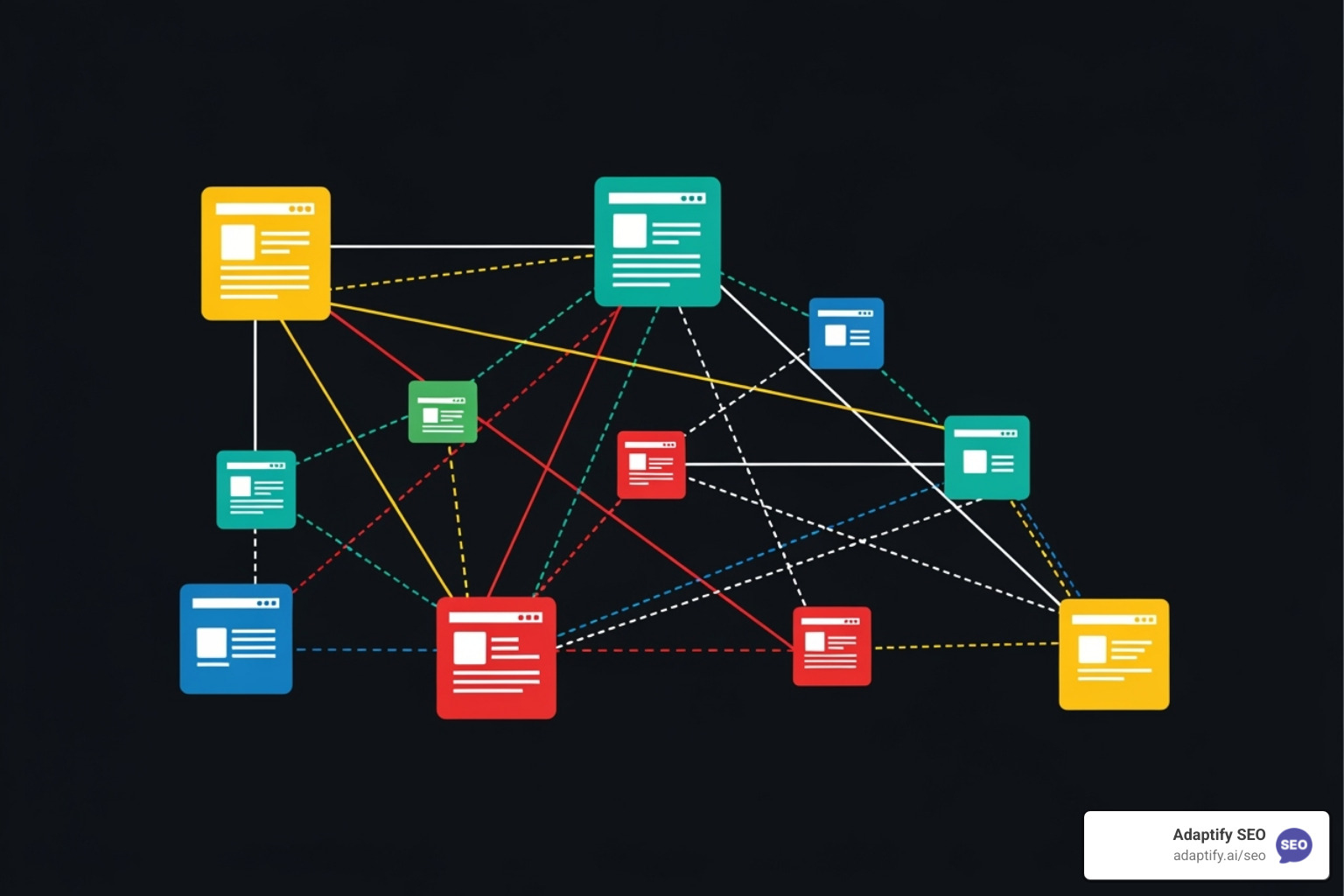
Understanding Key Backlink Metrics
Tools use different proprietary metrics, but they all measure link quality and quantity:
- Domain Authority (DA) / Page Authority (PA) (Moz): Moz's scores (1-100) predict how well a domain or page will rank. A higher score means stronger authority.
- Domain Rating (DR) / URL Rating (UR) (Ahrefs): Ahrefs' metrics (1-100) measure a site's or page's backlink profile strength. Ahrefs also shows estimated organic traffic to linking pages, a game-changer for evaluating link value.
- Authority Score (AS) (Semrush): Semrush's metric for domain strength. Some studies suggest its AS is more resilient to manipulation than Ahrefs' DR.
- Trust Flow / Citation Flow (Majestic): Majestic's Flow Metrics measure link quality (Trust Flow) and quantity (Citation Flow).
- Referring Domains: The number of unique websites linking to you. More unique domains generally mean a stronger profile.
- Anchor Text: The visible, clickable text in a hyperlink. It tells search engines what the linked page is about. A natural profile has a diverse mix of branded, naked URL, exact match, and contextual anchor text. Over-optimizing with exact-match anchors is a red flag for Google.
Quality trumps quantity. As Small SEO Tools says, "It is better to have 10 natural, high-quality backlinks than to have 100 low-quality ones."
Explore how PageRank relates to backlink quality.
Dofollow vs. Nofollow: What's the Difference?
Backlinks have attributes that tell search engines how to treat them:
- Dofollow Links: The default link type that passes "link equity" or "link juice," directly contributing to your SEO value and rankings.
- Nofollow Links: These use the
rel="nofollow"tag, telling search engines not to pass SEO value. However, as Semrush notes, they can still help rankings by driving referral traffic, building brand awareness, and contributing to a natural link profile. - Sponsored & UGC Links: These use
rel="sponsored"for paid links orrel="ugc"for user-generated content. They are treated like nofollow links and don't directly pass ranking signals, but they can still help marketing goals.
Every backlink plays a role in your online presence.
Leveraging Backlink Insights: Competitor Analysis & Improvement Strategies
Checking your own incoming links is just the beginning. The true power of backlink analysis lies in leveraging those insights, especially through competitor analysis. As I always say, learning from those who are winning at SEO is often the easiest route to better rankings.
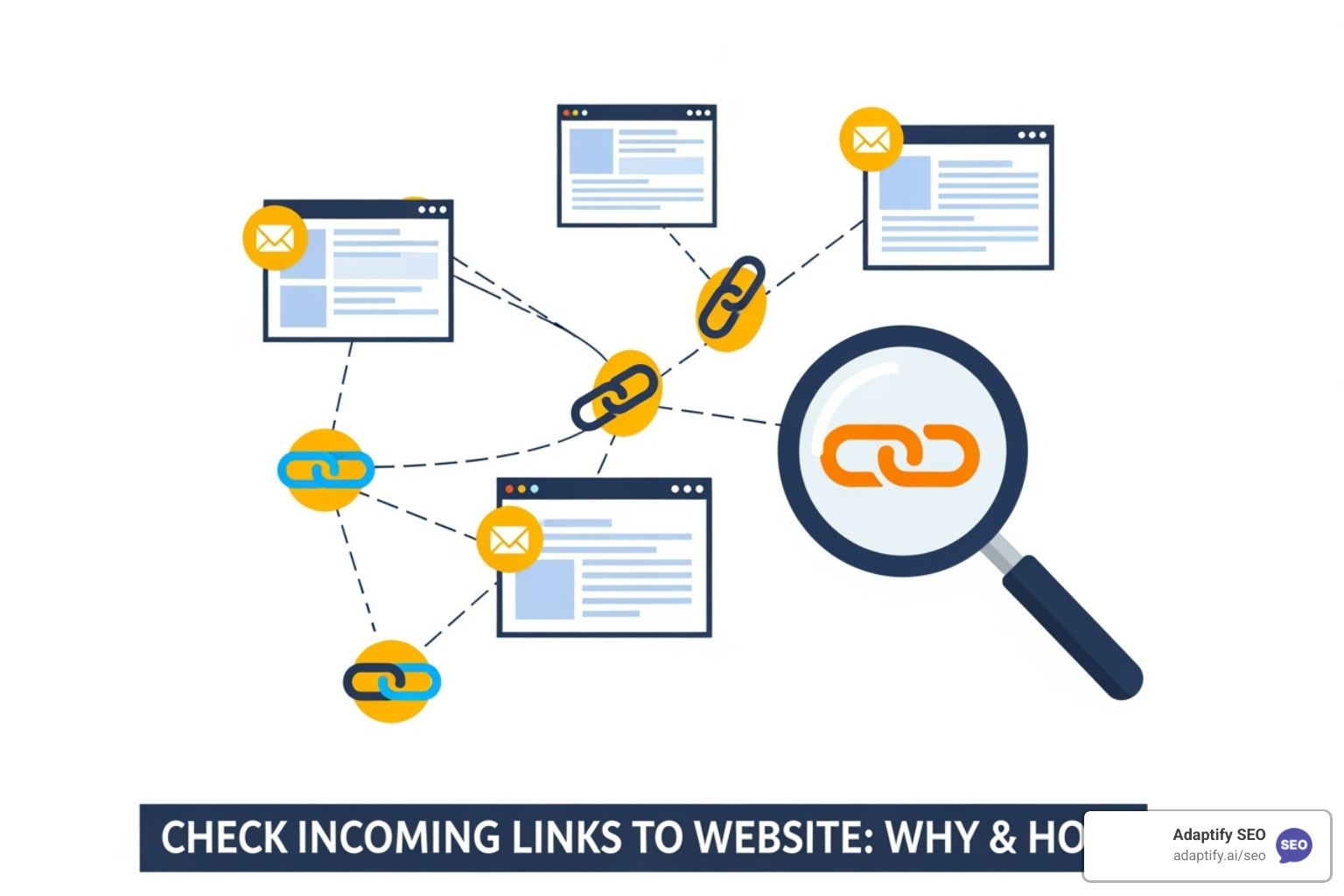
Analyzing Competitors to Find Opportunities
Your competitors' backlink profiles are a treasure trove of opportunities. By "spying" on their incoming links, you can uncover their linking strategies, identify valuable link sources, and find content gaps that you can fill.
Here’s what you can learn:
- Who links to them? If a site links to your competitor, they are likely in your niche and might be interested in linking to you too, especially if you can offer them something better or more relevant.
- What content gets linked? Identify their "linkable assets" – the pages or content types that attract the most backlinks. This can inform your own content strategy. For example, if your competitor's unique research or comprehensive guides are attracting links, you might consider creating similar, even better, content.
- How did they get those links? Did they guest post? Were they featured in a roundup? Did they create a tool or infographic that naturally attracted links? Reverse-engineering their tactics can reveal actionable outreach opportunities.
- Identify Industry Influencers: Analyze the backlink profiles of top-ranking websites in your niche to identify key influencers and authorities. These are often excellent targets for relationship building and potential future collaborations.
As Everywhere Marketer notes, "Spying on competitors' inbound links can uncover their linking strategies, providing new opportunities to improve your own SEO efforts." This isn't about copying; it's about intelligent emulation and finding your unique angle to attract similar, or even better, links.
Strategies to Improve Your Backlink Profile
Once you have these insights, it's time to act! Here are some effective strategies to build high-quality backlinks:
- Create High-Quality, Link-Worthy Content: This is foundational. As SEORankTools states, "Ensure you have quality content in place before focusing on link building efforts." This includes:
- Original Research & Data: Be the source! People love to link to unique studies, surveys, and data.
- Comprehensive Guides: Become the ultimate resource on a topic.
- Infographics & Visual Assets: These are highly shareable and attractive to link to.
- Case Studies & Success Stories: Demonstrating real-world results can attract attention.
- Guest Blogging: Write articles for other authoritative websites in your niche. This allows you to gain a contextual backlink to your site within content relevant to your audience. Choose influential and high-DA blogs for guest posting.
- Broken Link Building: Find broken links on other websites (especially those linking to outdated content or 404 pages). Then, create your own high-quality content on that topic and suggest it as a replacement to the website owner. It's a win-win: they fix a broken link, and you get a backlink.
- Unlinked Brand Mentions: Use monitoring tools to find mentions of your brand, products, or key personnel online that don't include a link back to your site. Reach out to the website owner and politely ask them to turn the mention into a clickable link.
- Relationship Building & Digital PR: Engage with industry influencers, journalists, and other website owners. This can involve collaborating on content, participating in expert roundups, or conducting outreach for earned media coverage. Digital PR, as Digital Third Coast highlights, can be a powerful way to grow your backlink profile through earned media.
- Reclaim Lost Links: Regularly monitor your backlink profile for links that have been removed or are now pointing to a 404 page. Reach out to the linking site to get the link reinstated or redirected.
The goal is to acquire relevant and authoritative backlinks. Focus on quality over quantity, and your efforts will pay off in improved search rankings and increased website authority.
Find effective link building strategies for higher rankings.
Managing Your Backlink Profile: Auditing and Quality Control
Checking incoming links is not a one-and-done task. Your backlink profile is dynamic, constantly changing as new links are gained and old ones are lost. Regular backlink audits are essential to maintain a healthy profile, identify potential threats, and ensure your link-building efforts are paying off.
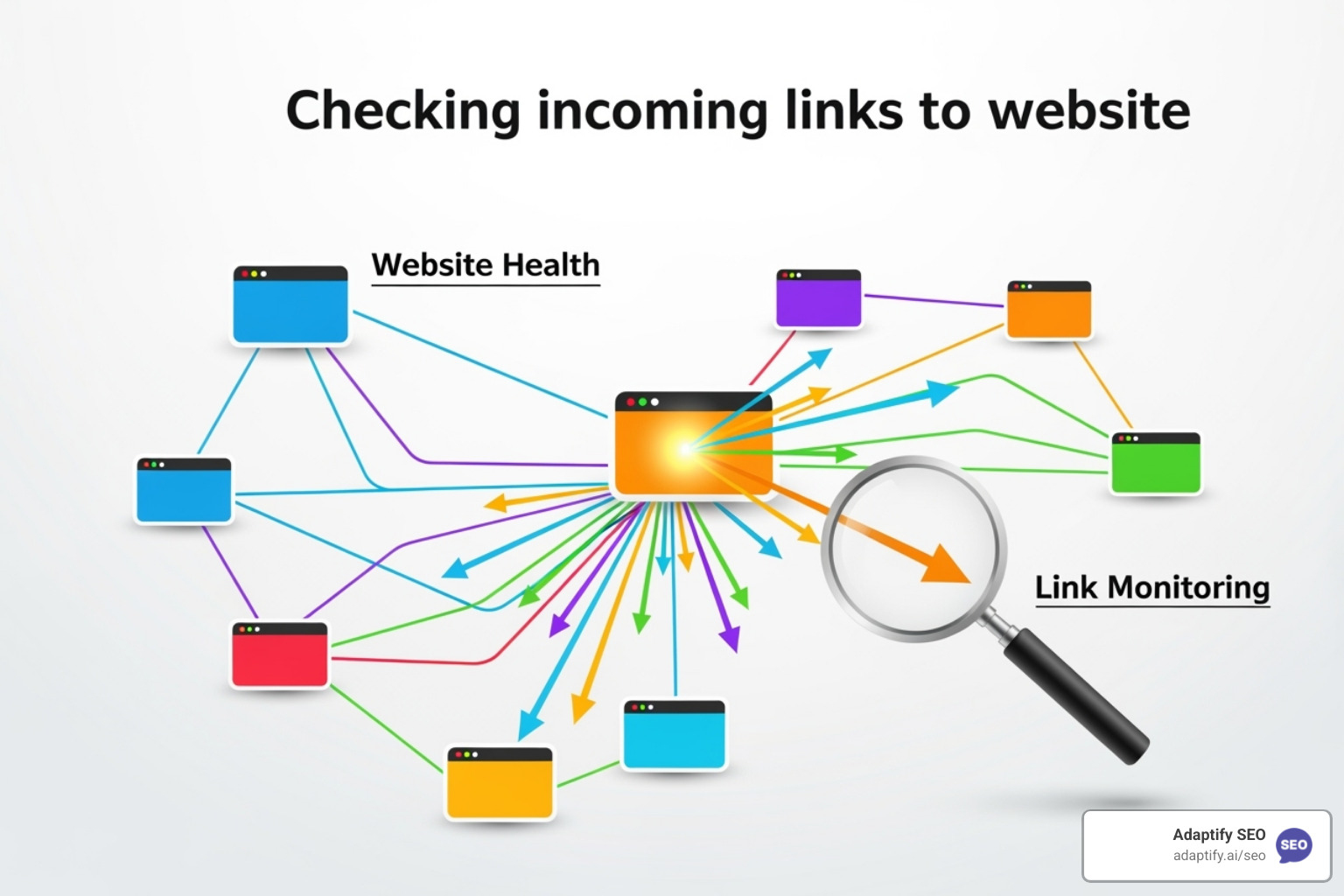
Identifying and Addressing Low-Quality Links
Just as good links boost your SEO, bad links can actively harm it. Low-quality, spammy, or irrelevant links can signal to Google that you're engaged in manipulative tactics, potentially leading to Google penalties or holding back your rankings. Google has rolled out algorithm updates specifically to devalue low-quality links, and it considers unnatural links a violation of its guidelines.
What constitutes a "bad" link?
- Spammy Websites: Links from sites known for spam, malware, or illicit content.
- Irrelevant Content: Links from websites completely unrelated to your niche or content.
- Unnatural Link Patterns: A sudden, suspicious surge of links, or links from a network of low-quality sites designed solely for link building.
- Aggressive Anchor Text: Overuse of exact-match anchor text, especially from low-quality sources.
- Negative SEO Attacks: In rare cases, competitors might point spammy links at your site to try and harm your rankings.
If you identify such links during your audit, you have a few options:
- Link Removal Requests: The ideal scenario is to contact the website owner and politely ask them to remove the link. This can be time-consuming and often unsuccessful, but it's worth trying for particularly egregious links.
- Google's Disavow Tool: This is your last resort. The disavow tool allows you to tell Google to ignore specific links pointing to your site. It's a powerful tool but should be used with extreme caution, as misusing it can harm your SEO. You can add spammy links directly to a disavow file from some backlink checker tools and then import it into Google's Disavow Tool.
Regular monitoring and auditing are your best defense against negative SEO and maintaining a clean link profile. My experience has shown me that identifying and addressing these low-quality links is just as important as building good ones.
Find how to perform a comprehensive SEO audit for your website.
Proactive Backlink Management
Beyond just cleaning up bad links, proactive management involves nurturing your existing link profile and ensuring you retain the value from every link you've earned:
- Link Reclamation: This goes hand-in-hand with broken link building. If you find your own pages that used to have backlinks are now 404s, you can reinstate the page, redirect it to a relevant live page (using a 301 redirect), or reach out to the linking site to update their link. This helps avoid "link rot."
- Content Updates: Regularly update your existing content. Fresh, relevant content is more likely to retain its backlinks and even attract new ones. This also helps keep your pages live and avoids them becoming broken link sources.
- Continuous Improvement: Backlink management is an ongoing process. Use the insights from your backlink analysis to refine your content strategy, improve your outreach efforts, and continuously build on your successes.
A strong backlink profile is not static; it's a living, breathing part of your website's SEO health.
Frequently Asked Questions about Checking Incoming Links to Website
I often get asked specific questions about managing backlinks, so I've compiled some common ones here to help you further.
How often should I check incoming links to my website?
Posing the question, "Who links to my site?" is not a one-time task; it's continuous. I recommend checking your incoming links regularly, especially if you're actively engaged in link building or frequently updating your website's content. For most businesses, a monthly check is a good starting point. However, if you've recently launched a major link-building campaign, experienced a significant Google algorithm update, or are troubleshooting ranking issues, you might want to monitor them weekly. Consistent monitoring helps you quickly identify new links, lost links, and any potential issues or opportunities.
Can a nofollow link still be valuable for my website?
Absolutely! While nofollow links don't directly pass "link equity" for SEO ranking purposes, they can still be incredibly valuable. As I mentioned earlier, "nofollow links, contrary to popular opinion, can directly help with search rankings and bring substantial referral traffic."
Here's how:
- Referral Traffic: A nofollow link from a high-traffic, relevant website can send a significant amount of targeted visitors to your site. This direct traffic can convert into leads or sales, regardless of SEO value.
- Brand Awareness: Being mentioned on authoritative sites, even with a nofollow link, increases your brand's visibility and reputation.
- Natural Link Profile: A healthy backlink profile includes a mix of dofollow and nofollow links. An exclusively dofollow profile can look unnatural to search engines and might raise red flags.
- Indirect SEO Benefits: A nofollow link might lead to a dofollow link. For example, if someone finds your content via a nofollow link on a forum, they might then link to you from their own blog with a dofollow link.
So, don't dismiss nofollow links. They play an important role in a holistic digital marketing strategy.
What should I do if I find a spammy or low-quality link pointing to my site?
Finding spammy or low-quality links can be concerning, but don't panic. Here's my advice:
- Assess the Risk: Not all bad links are created equal. Google is quite sophisticated at ignoring low-quality links, so minor spam might not warrant action. However, if you see a pattern of manipulative links, or if you suspect a negative SEO attack, you need to act.
- Attempt Removal (Optional but Recommended): If feasible, try to contact the website owner and politely request the link's removal. This is the cleanest solution.
- Use Google's Disavow Tool (Caution Advised): If you can't get the link removed, or if you have a large number of spammy links that you believe are harming your site, use Google's Disavow Tool. This tool allows you to tell Google to ignore specific links. I can't stress this enough: use this tool with extreme caution. It's designed for advanced users and can negatively impact your site if misused. Only disavow links that you are confident are spammy and detrimental.
- Monitor: After taking action, continue to monitor your backlink profile and search rankings to see if the situation improves.
The goal is to maintain a clean, high-quality backlink profile that Google trusts.
Conclusion
Understanding, analyzing, and managing your incoming links is not just an SEO best practice; it's a fundamental pillar of online success. Backlinks are the digital endorsements that signal your website's credibility and authority to search engines, directly impacting your search rankings and website authority.
The process of checking incoming.links to website performance, interpreting complex backlink data, analyzing competitors, and implementing effective link-building strategies can seem daunting. But with the right tools and a proactive approach, it becomes a strategic advantage.
At Adaptify SEO, we're dedicated to making this process simpler and more efficient for you. Our automated solutions are designed to streamline your SEO workflow, helping you gain actionable insights into your backlink profile without the manual headaches. Whether you're based in Melbourne, Sydney, Brisbane, Perth, Adelaide, Auckland, Singapore, or London, our platform is built to support your growth.
By consistently monitoring your backlink profile, focusing on quality over quantity, and leveraging comprehensive tools, you're not just checking links – you're actively shaping your website's future in search results.
